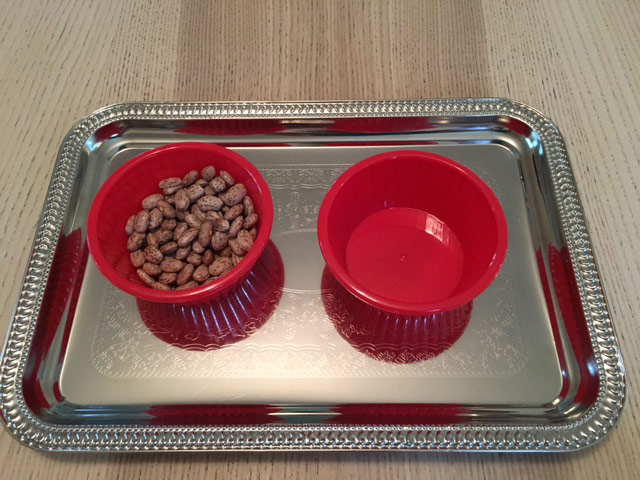The goal of Practical Life activities are to help build a child’s concentration, self-confidence, independence and coordination, all while contributing to the child’s development. Here are a few helpful hints as you engage with your child in these activities:
- Do all movements slowly, setting the child up for success
- Encourage your child to keep trying – if materials spill, invite them to try again perhaps slower this time. The objective is to build their concentration
- As you demonstrate, work left to right (training the brain for reading), have fun with the activity, and speak softly and slowly
- Invite your child to listen to the sounds as the “beans” drop into the empty bowl, etc.
- Enjoy changing up the materials you use, keeping in mind the seasons, the time of year, and the age and interests of your child. Shop your home for age appropriate containers, materials and tools. The Dollar Store also has fun items.
Control of Movement: There are four areas of movement control:
- Transfer
- Twist (hand-wrist)
- Grasp (Finger-hand), and
- Hand-Arm control
Transfer Activities
In this article we will focus on Transfer. Here we will introduce to the child the idea of transferring an item from one place to another, using tools.
Here is what you will need: a large pot, bowl or container of some sort; dry beans or a bag of similar size items; objects to hide in the beans that your child will enjoy searching for, scoops of different sizes, spoons, toothpicks and a shaker jar of some sort.
We will begin by encouraging the child to simply enjoy using their hands to feel the items (whatever you choose – in our example we use beans) in the container, and work our way up to transferring using two hands, one hand, finger, scoops, spoons and finally a spatula.
Step 1: Bean feeling
Hide objects in a large pot of beans. Be sure to set the child up for success: use a container large enough that the beans won’t spill, and use items they will enjoy feeling and finding. Encourage your child to put their hands in the beans, feeling the beans and feeling for the buried objects.

Step 2: Two hand transfer
Place your dominant hand inside the bowl with the beans, while holding the bowl with your receiving hand. Grasp objects in the bowl with your fingers and transfer them to one of the smaller bowls.
Step 3: Single hand transfer
Place your dominant hand inside the bowl with the beans while holding the bowl with your receiving hand. Grasp beans with fingers, transferring them to the other bowl. Continue until all of the beans are transferred. Repeat
Step 4: Finger transfer
Begin with objects in one container. Using the pincher grip (thumb and pointer finger) pick up one object at a time and transfer into the other container. Then transfer each object, one at a time, back to the original container.

Step 5: Finger transfer toothpick in a container
Have toothpicks in a small container. Find another container that has holes (a sugar or spice shaker perhaps) that you can empty and use. Using the pincher grip (thumb and pointer finger) transfer the toothpicks individually from the small container into the shaker top of the other jar. When finished, take the container in the subdominant hand and unscrew the lid with the dominant hand. Return the individual toothpicks into their original container and try again.

Step 6: Scooping
Select a scoop that will be successful for the age of your child, along with objects that will fit in the scoop. With the scoop in your dominant hand, using the subdominant hand to hold the bowl, scoop objects from one bowl to another. Praise your child’s accomplishment and start again, returning the objects, by scooping, to the original bowl.

Step 7: Spooning
The same steps as above, only this time using a more challenging tool – a spoon! Start with a size to set your child for success. You can adjust as your child continues to master this new skill. If your child is up for it, as a final challenge try a spatula!
